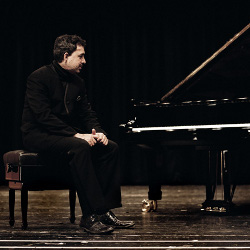
M usical ideas are such combinations of tones, rhythms, and harmonies as to demand/inspire a thoughtful treatment like the main theses of a philosophical tract. [Any non-trivial musical idea inevitably] raises a question—sets up a problem that, in the course of the piece, has to be answered, resolved, ‘carried through’. It has to be carried through however many contradictory situations are plausible; it must be developed by deducing however many inferences there may be from what it postulates; it has to be checked—has to be proved to be true, like a mathematical theorem. And all this, if you are successful, will lead to a conclusion—a ‘pronunciamento’, a fresh new certainty—a beautiful new discovery [that speaks].”T he quote above was one we saw in the Arnold Schönberg Center archives, when we visited Vienna a couple of months ago. I was reminded of this insight of Schoenberg’s during Bach’s complete two- and three-part Inventions (Sinfonias), performed by Konstantin Lifschitz last night. Interleaved Invention-Sinfonia-Invention-Sinfonia as they were, in ascending chromatic sequence (as opposed to chronologically; as opposed to rank-order by pedagogic difficulty in Wilhelm Friedemann’s Klavierbuchlein), the pieces led us in the audience to some new insights.
— Arnold Schoenberg, ‘Beauty and Logic in Music,’ unpublished manuscript.
S ome inventions, performed by many at faster tempi, became intense meditations on color and timbre. Other ones, often performed with wider rubato variation, became motoric illustrations of individual conviction and duty. Consider the editorial suggestions of the Alfred or others’ modern editions; consider the ur-texts of Bach himself; but make up your own mind—find your own true story. Which is what Konstantin Lifschitz did for us so wonderfully and spontaneously last night.
T hese inventions began as [mere] ideas, that Bach conceived [in an improvisational, impromptu manner] and wrote as teaching tools. The complexities of the three-voice Sinfonias make the two-part Inventions seem [simple] when you play them side-by-side.”I t’s a joy to hear the unfiltered account of a friend’s or lover’s dream. We feel touched and, not just ‘connected’, but also more ‘human’ for the shared experience... ‘included’, ‘alive’. We are included in the ‘action’, and we feel the curiosity and the moral duty to engage with the friend who is relating this dream to us. We sense the truth that arises from the honest synapses firing without the interpolation of an ego in the process. The purity of (absence of—) motives and the transparency count for a lot.
— Cynthia Siebert, founder, Friends of Chamber Music.
I st das möglich? Denkt ihr, man kann sich wirklich mit einer musikalischen Idee durch einen Traum verlieben, bzw. kann man tatsächlich träumen, verliebt sich in die musikalische Idee zu sein? Habt ihr sowas schon mal geträumt?
[Is this possible? Do you think you can really fall in love with a musical idea in a dream, or dream you can actually love to be in the musical idea? Have you dreamed something like this before?]”
— Milton Babbitt.
- Konstanin Lifschitz website
- Schoenberg A. The Musical Idea, and the Logic, Art, and Technique of its Presentation. Carpenter P, Neff S, eds. Indiana Univ, 2006, pp.395-6.
- Palmer W, ed. J. S. Bach: Inventions & Sinfonias. Alfred, 2004.
No comments:
Post a Comment